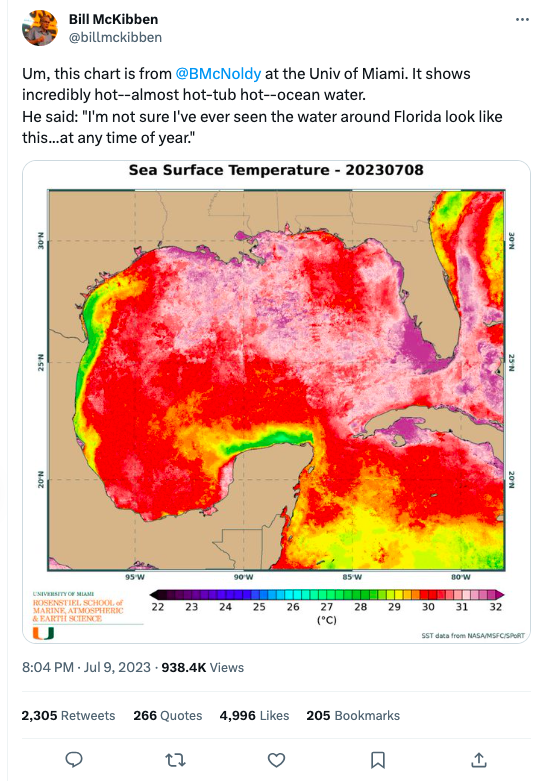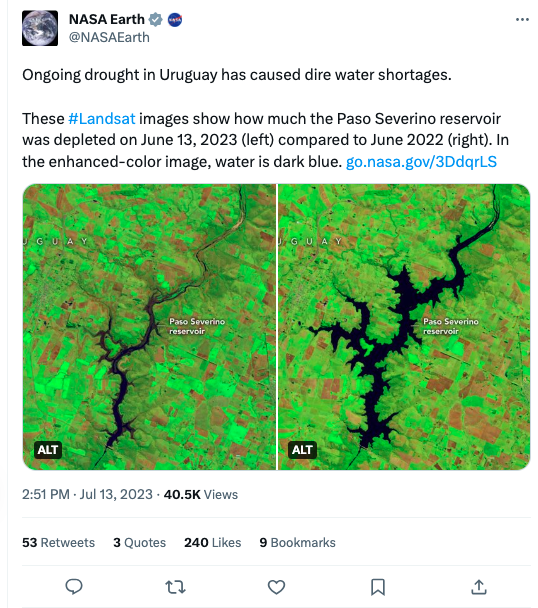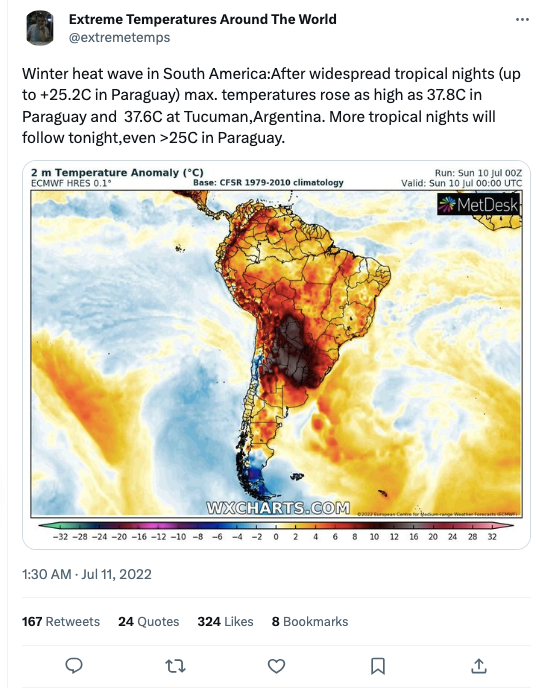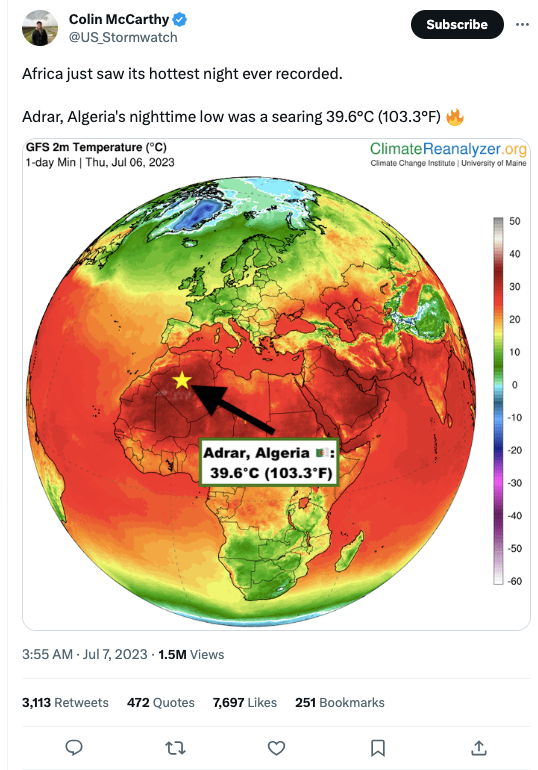
Media reaction: Extreme weather hits world’s seven continents in July 2023
Multiple Authors
07.18.23From Africa to Antarctica, all seven of Earth’s continents have experienced extraordinary extreme weather events this month.
The start of July saw Earth experience its hottest week on record.
Extreme weather events across the globe this month have already featured on more than 114 frontpages in at least 84 newspapers, published across 32 countries, Carbon Brief analysis shows.
Many nations are grappling with extreme heat, with China setting a provisional new national temperature record of 52.2C, Antarctica sea ice at record low levels amid unusual winter heat and Africa experiencing its hottest night ever.
Other regions are facing deadly floods. More than 100 people have been killed in deluges in India and at least a dozen people have died in floods in South Korea.
Below, Carbon Brief’s global team of journalists analyse how national and international media have covered the deadly extremes affecting Europe, North and South America, Africa, Asia, Oceania and Antarctica.
- The ‘Cerberus’ heatwave in Europe
- Deadly floods in India and Pakistan
- Floods and record heat in the US
- Extreme heat and drought in Uruguay
- Record wildfires in Canada
- Extreme heat in the Middle East and North Africa
- Floods and record heat in China
- Floods in South Korea, Japan and the Philippines
The ‘Cerberus’ heatwave in Europe
A high-pressure system named Cerberus, after the three-headed dog of Greek mythology, has caused temperatures across Europe to surge to near record levels, according to the Conversation.
Temperatures over the past week have surged across southern and eastern Europe, including France, Spain, Poland and Greece.
The extreme conditions in Europe made the frontpages of French newspaper Le Monde, the UK’s Daily Mail and Gulf News, an English-language newspaper published from Dubai, among many other publications.
A second “heat storm” dubbed Charon, after the ferryman that carries souls over the river Styx in Hades, is set to push temperatures even further across the coming week, according to the Daily Telegraph.
Temperatures well above 45C are forecast in parts of Italy, Spain and Greece, the Independent reported, and could get as high as 48C in Italy’s Sardinia. The hottest temperature ever recorded in Europe was 48.8C in Sicily in 2021.
Described as a “tongue of fire” by the Il Messaggero newspaper in Rome, the intense heat has also reached Italy.
Major cities such as Rome, Bologna and Florence are among the 10 in Italy now under red alert due to the intense heat, according to BBC News. By Wednesday, this had increased to 23 cities across Italy, according to an update from BBC News. Local media described the heatwave as “settimana infernale” or “week of hell”, the article continues.
In Rome, temperatures are expected to beat the previous record high of 40.7C, set in 2007, with 42-43C forecast as “infernal days” hit main cities, reported Italian newspaper La Repubblica.
While Italy is experiencing much of the worst of the heatwave, national papers have not led with the story, noted the Guardian. In many places, the bufera – or storm – that has been caused by deputy prime minister Matteo Salvini’s call for amnesty for tax evaders has taken centre stage.
Health warnings have been issued throughout the country, Metronews reported. Both BBC News and the Guardian reported that many people have collapsed in Rome and Milan due to a lack of water and dehydration.
Italian hospitals have now seen a sharp rise in emergency cases, the Guardian reported, with some seeing a 20-25% increase. Reuters covered the health risks extreme heat presents, while the Associated Press and Grist launched a new series on human health and climate change.
Similarly, the Hill carried the World Meteorological Organization’s warning around the increased risk of heart attack amid the extreme temperatures.
From Thursday, temperatures are expected to cool, particularly across the northern regions of Italy, as thunderstorms arrive, according to 3bmeteo.
In Greece, the Acropolis was shut from noon until 5pm on 14 July in the name of “protecting” visitors from the sun, according to the Guardian.
Temperatures hit 45C in Syntagma Square in Athens – which due to its altitude and lack of shade is typically a few degrees warmer than the wider city – and are likely to have matched this on the rocky outcrop of the Acropolis, the Guardian said. Its article continued:
“Up at the Acropolis, the realities of the climate emergency were on full display as it becomes ever more evident that the future will be fraught with difficulty as humans and urban environments attempt to adapt to temperatures accelerating with a speed few had envisaged.”
It remained closed during the hottest hours over Saturday and Sunday, according to the Daily Telegraph, as several tourists were still sent to the hospital in the Greek capital.
The closure of the Acropolis due to extreme heat made the frontpage of newspapers around the world including La Vanguardia, a Spanish daily newspaper, as well as the Wall Street Journal in the US, the Malta Independent and the Rheinische Post in Germany.
Elsewhere, at least 46 forest fires broke out around Greece over Sunday, according to the Times, although all are now under control. Two “raged uncontrolled” through coastal towns near Athens on Monday, prompting evacuations as at least five homes were destroyed, reported Reuters.
The fires are still raging after three days, according to the Guardian, leading water bombers to be flown in from Italy and France to join the firefighting operation.
On the Spanish island of La Parma, more than 4,000 residents were evacuated as a wildfire spread, according to the Independent. The fire began in the early hours of Saturday morning in El Pinar de Puntagorda and had affected around 4,500 hectares (11,120 acres) of land and destroyed at least 12 homes by the early afternoon, according to Reuters.
Elsewhere, on Tenerife, another of Spain’s eight Canary Islands, a forest fire broke out, leading to 50 people being evacuated, according to the Daily Telegraph. Temperatures are set to reach above 40C in the Canary Islands as well as the southern Andalusian region of Spain over the coming week, the article noted.
The evacuation of people away from forest fires in Tenerife made the frontpage of the Portuguese daily newspaper Jornal de Notícias.
In Croatia, a bushfire near the Adriatic town of Sibenik raged on Thursday, according to CNBC. In total, 56 firefighters with 20 vehicles and three aircraft were brought in to fight the blaze.
Flames and thick smoke rose above scorched houses and burned cars in Croatia as wildfires broke out https://t.co/2LeQPONrlG pic.twitter.com/5P30joij1u
— Reuters (@Reuters) July 14, 2023
Much of the Balkans were hit by the heatwave last week, according to Reuters, with meteorologists and doctors in Montenegro, Bosnia and Serbia calling for people to stay indoors where possible and drink plenty of liquids if they venture out.
In Northern Europe, Cerberus made frontpages, with Die Presse in Austria warning of the risks of record heat, De Telegraaf in the Netherlands highlighting “heat alarm” and Dagbladet in Norway stating that researchers have warned there could soon be 40C temperatures in the country.
On Sunday, Agora in Poland ran with the headline: “It will be like hell: Saudi Arabia recorded 48C, Spain 44C, and Poland will soon be flooded by 35C heat.”
In Turkey, the Milliyet daily newspaper called on people to not be “heartbroken in this weather” as the Hatay province fought flames. The Oksijen newspaper, meanwhile, warned: “It’s hot…it’s going to be even hotter.” Korkusuz stated: “Turkey is burning.” And a separate Milliyet piece asked: “Record hot! But what will they [earthquake victims] do?”

Deadly floods in India and Pakistan
After a delayed start to this year’s monsoon that brought another deadly, early summer to an end, South Asia was once again hit by record-breaking monsoon rains that wrought devastation in north India and Pakistan.
News coverage of flash floods and landslides peaked in the week starting 10 July, after videos of Himalayan rivers flooding towns and sweeping bridges away went viral on social media.
थुनाग बाजार जिला मंडी में देखिए तबाही का मंजर । pic.twitter.com/WbfDBYf7oP
— Rishu🇮🇳 (@Rishusharma26) July 9, 2023
On 10 July, estimates of fatalities from the floods on that day differed: the Times of India reported 22 deaths, while the New York Times said 49.
The Guardian reported that Delhi received 153mm of rain, “the highest precipitation in a single day in July in 40 years”, while the mountain-state of Himachal Pradesh “received a month’s rainfall in a day”. The cold desert region of Ladakh – previously in the state of Jammu and Kashmir – received more than 10,000% of its normal rain on 8-9 July, according to Down to Earth.
The flash floods and landslides made the frontpages of the Times of India, Hindu, Hindustan Times, Asian Age and Pakistan’s National Herald Tribune, among other outlets.
Overseas outlets, including the Straits Times in Singapore, Daily Trust in Nigeria and Arab News in Saudi Arabia, also covered the floods, but reporting in developed countries was limited.
In an explainer in the Hindustan Times, India’s meteorological authorities and climate experts both pointed to major changes in the amount of rainfall, from a deficient June to a 2% nationwide excess in July, driven by a “surge over the west coast and parts of northern India in the past week”.
While the India Meteorological Department (IMD) chief quoted in the piece attributed the heavy rainfall to “an interaction between a western disturbance and the monsoon”, his quote did not mention climate change.
In contrast, India’s former earth sciences secretary M Rajeevan is quoted saying “one of the important impacts of climate change on monsoon: it rains fewer hours, but when it rains, it rains very heavily”.
“This is a clear climate change signal,” climate scientist and IPCC author Dr Roxy Matthew Koll told the Daily Telegraph, while highlighting how the hills are “particularly susceptible to heavy rains and landslides” and that flash floods and cloudbursts are “hard to predict”.
The story quoted Intergovernmental Panel on Climate Change (IPCC) lead author on water, Dr Aditi Mukherji, who said the floods were also “partly a result of development models that did not factor in the caution while building in ecologically fragile zones”.
Mahesh Palawat at the private weather agency Skymet told the Independent:
“There has been a constant rise in both land and sea temperatures, which has increased the capacity of the air to hold moisture for a longer time. [T]he role of climate change in the increasing extreme weather events in India has been strengthening with each passing year.”
On 11 July, Bloomberg reported that several hydropower plants in Himachal Pradesh “have suspended operations due to flooding and high silt levels”. Five days later, it reported that some plants were restarting operations even as “yet more rain looms”, adding that “while India sees hydropower as vital to its energy transition, environmental and social challenges have slowed capacity additions and boosted costs”.
Across the border in Pakistan, Nikkei Asia reported that up to a million people were affected by “cloudbursts and flash floods in multiple cities”. According to the story, many “fear[ed] a repeat” of last year’s floods attributed to global warming, with water authorities arguing that Pakistan needed “more dams…to use floodwater for our benefit”. Others argued that “bitter rivals” India and Pakistan “have a good starting point to collaborate on early warning systems for floods”.
By this time, in India, the spotlight for accountability for the floods had shifted to infrastructure and development choices in affected regions, and a failure to adapt.
“More needs to be done for climate adaptation to prevent economic losses and food insecurity,” Centre for Science and Environment’s (CSE) Sunita Narain told Deutsche Welle, pointing out that India needed to “relearn land- and water-management strategies…fast” in a “climate-variable world”.
Stories in the Hindustan Times looked at the “mindless concretisation” of the Himalayan region, attributing impacts to forest cover loss, infrastructure development, river-bed mining and tourism. In another piece in the Hindustan Times, ecologist Manshi Asher said:
“[B]laming excess rainfall or demonising rivers cannot hide development excesses and faulty planning that eroded local capacity to climate vagaries.”
An editorial in the Hindu called on states to end “blame games” and cooperate in the face of the “increased probability of spells of extreme rain, given warming trends”, urging them to develop a “joint strategy on floods” similar to those in place for air pollution.
The hardest-hit Indian state of Himachal Pradesh was struck by another cloudburst on Monday, taking the death toll in the state up to 111 people, according to the Tribune.
Most rivers have crossed the “danger mark”, the Hindu reported, and flood waters entered over 100 villages because of “incessant rainfall in catchment areas of Nepal”.
The Kathmandu Post reported that “at least 30 people” have died in landslides and floods in Nepal since the start of monsoon.
On Tuesday, the Times of India reported that the Yamuna river’s floodwaters had touched the walls of the Taj Mahal in Agra for the first time in 45 years.
On 18 July, Reuters reported that further flash floods in the state of Assam killed eight people and and displaced more than 115,000, submerging crops, homes and nearly half of the Kaziranga National Park. Another Reuters looked at how “uneven rainfall distribution” has farmers worried.
At least 16 people were killed in a landslide in Irshalwadi, 37 miles from Mumbai, the Indian Express reported. The tribal hamlet, in the coastal district of Raigad, received “as much as 400mm rain in the last 24 hours”, Reuters added, while reporting separately that the Yamuna river had flooded the holy cities of Vrindavan and Mathura.
On 20 July, Dawn reported that 11 workers in Islamabad were killed when a wall “weakened by rains” collapsed on them while they were sleeping, while in Lahore, five people including two children “were electrocuted in different areas amid rains”.
Economic damage from the floods in India so far are estimated at nearly $2bn by a State Bank of India report, Nikkei Asia wrote. While “state politicians are pointing fingers”, the outlet continued, climate change “receives relatively little attention from most Indian politicians and has yet to become a major [2024] poll issue…although the Modi government has made it a priority as host of the G20 this year”.
Environmentalist Leo Saldanha was quoted by Nikkei saying that decision-making that shapes cities “respond[s] to communities with agency – typically middle and upper classes [or] castes”. He added:
“As a result, we find almost always that poor and those without agency suffer calamities more.”

Floods and record heat in the US
Dozens of newspapers in the US carried frontpage stories on weather extremes across the country, from brutal heat in the southern and south-western US to torrential downpours and flooding in the north-east.
The Los Angeles Times proclaimed the events “a new abnormal”.
The Wall Street Journal featured Europe’s heatwave on its frontpage, but declined to mention any of the extremes battering the US.
Former US vice president Al Gore told the New York Times that “everywhere you look in the world, the extremes have now seemingly reached a new level”. Gore added:
“Fossil fuel companies are desperately trying to use their political and economic networks and their successful capture of policy in too many countries to slow down this transition…They don’t disclose their emissions. They don’t have any phase-out plan. They’re not committed to a real net-zero pathway. They’re greenwashing. They’re performing anti-climate plotting.”
A “historic” and “relentless” heatwave is gripping much of the south-western US, where it has “established numerous records well above 100F” (37.8C), according to the Washington Post.
The newspaper noted that, while the heat was expected to “very slowly ease” over the western US over the coming week, “it is expected to become more entrenched and expand over the south-central and southeastern US”. Those regions are already facing “dangerously high heat indexes” due to “tropical-like humidity”, it added.
The heat put nearly one-third of the US population – more than 100 million people – under excessive-heat advisories, watches or warnings every day since 11 July through at least 20 July, according to the US National Weather Service.
Axios reported that 80 million Americans “are expected to face an air temperature or heat index above 105F (40.6C)” over the weekend of 22-23 July, noting that the temperature extremes “have been exacerbated by human-caused climate change” and pose “an immediate risk to public health”.
On 19 July, Austin, Texas reached temperatures of 105F (40.6C) for 10 days in a row “for the first time in recorded history”, according to the National Weather Service.
At Las Vegas’s Harry Reid international airport, “multiple passengers passed out and had to be wheeled away in stretchers” on 17 July after their flight sat on the tarmac in 111F (43.8C) heat for several hours, the Independent reported.
Over the weekend of 15-16 July, all eyes were on Death Valley, a national park on the California-Nevada border. The park – which holds the world’s temperature record of 134F (56.7C) – was forecast to potentially break that record. Death Valley “is tailor-made to bake”, due to the surrounding mountains and the low elevation, according to the Los Angeles Times.
The newspaper reported that “dozens of people came to take pictures with the thermometer at the visitor centre” on Sunday and Monday.
Temperatures in Death Valley peaked at 128F (53.3C) on 16 July, shy of the record. The Los Angeles Times wrote that “the hots will keep getting hotter as the burning of fossil fuels continues to heat the planet”, adding that “seven of Death Valley’s hottest summers on record have occurred in the last 10 years”.
And, on 17 July, Death Valley recorded temperatures of 120F (48.9C) between midnight and 1am. “If confirmed it would be the hottest recorded temperature at that time,” New Scientist wrote.
Southern Florida’s Miami-Dade county saw its first-ever excessive heat warning on 16 July, National Public Radio (NPR) reported. Water temperatures around Florida also reached “really unprecedented” highs, according to another NPR story, with one buoy measuring temperatures greater than 98F (36.6C) last week.
Prof Ben Kirtman, an atmospheric scientist at the University of Miami, told NPR:
“It’s bonkers. I don’t know how else to put it. It’s out of bounds from what we’ve seen. If you just wrote a statistical model and said what are the chances of this level of warming, it would be 1 in 250,000 years that that would happen.”
On 19 July, the country’s fifth-most-populous city, Phoenix, hit high temperatures of at least 110F (43.3C) for the 20th day in a row – extending a record that had been broken the day before. The previous record, set in 1974, was 18 days in a row of temperatures of 110F or higher.
Mother Jones noted that “the heat is particularly extreme this year because of the combination [of] climate change and the return of El Niño”.
Axios, covering an initial analysis produced by Climate Central, wrote that in some of the affected areas of the US, “climate change has likely made record-breaking temperatures at least five times more likely”.
The Associated Press quoted the records coordinator of the World Meteorological Organization:
“Long-term: global warming is causing higher and more frequent temperature extremes. Short-term: this particular weekend is being driven by a very, very strong upper-level ridge of high pressure over the western US.”
Some outlets reported on how the extreme heat disproportionately affects marginalised populations, with the Arizona Republic covering the heat’s impacts on the state’s homeless population – an issue also noted on a Miami Herald frontpage. Joyce Obiru, who has been experiencing homelessness since 2016, told the newspaper:
“People are staying in these tents, and everyday somebody is dropping, we are just listening to people die because of this heat…It’s very painful to see. And it’s very painful to experience.”
The elevated temperatures coincided with a lack of rainfall to put parts of northern Texas at risk of wildfires, according to the Dallas Morning News. Fires also broke out in parts of southern California, Oregon and Arizona, noted the Washington Post.
Temperature extremes were not the only severe weather phenomena facing the US.
Tropical storm Calvin “lashed Hawaii, raising the potential for flash flooding and dangerous surf on the Big Island, Reuters wrote on 19 July. However, the storm “came and went without causing any significant damage”, the Honolulu Star-Advertiser reported.
Hawaii governor Josh Green noted that “the extensive preparations for Calvin were worthwhile because the busier part of the hurricane season is yet to arrive”, the newspaper added.
On 19 July, Kentucky governor Andy Bashear declared a state of emergency for the western part of the state “after overnight rain that rolled through the region led to flash flooding in some areas”, according to the Courier Journal, a Louisville-based newspaper. The outlet added that according to a local meteorologist, “more than 11in (27.9cm) of rain had fallen in 24 hours in Mayfield, which would set a new state record”.
The Lexington Herald Leader wrote that 20 July may bring additional rainfall, noting that:
“Though two more inches of rain isn’t much in and of itself, saturation of the soil from yesterday’s torrent is a primary concern for the region in dealing with the additional rain.”
Record rainfall “pounded” the north-eastern US over the weekend of 8-9 July, NBC News reported, while melting snowpack in California “flooded more than 110,000 acres of premium farmland…sinking tractors, electrical equipment and farmhouses”.
The north-east’s “torrential downpours” put more than 13 million people under flash flood watches and warnings, Reuters reported.
In some parts of Vermont, nine inches (22.9 centimetres) of rain – nearly one-fifth of those areas’ typical annual rainfall – fell in just two days, NBC News wrote. The outlet added that “a warmer atmosphere can hold more moisture, which makes extreme rainfall more likely.”
The Philadelphia Inquirer reported that at least five people had died during the “destructive flooding” in Bucks County, just north of Philadelphia. During a two-hour period on 16 July, 4.5in (11.4cm) of rain fell on the county, the newspaper wrote.
In New York State’s Hudson Valley, a region stretching north from New York City along the Hudson River, flooding disrupted municipal water supplies, “filled basements, washed away roads and left some people without homes at all”, reported Gothamist, a New York City-based news outlet.
New York governor Kathy Hochul called the flooding a “1,000 year event”, adding that such storms “are now the new normal due to climate change”, Gothamist wrote.
However, an analysis from Media Matters found that just 10% of national television coverage of the flooding mentioned the role of climate change. The outlet noted that Fox News’s coverage “mentioned climate change once to deny the role it played in the flooding”.
In Slate, volunteer firefighter Myke Cole, from Hudson Valley, wrote that the flooding in the north-east “is the type [of natural disaster] we can expect more frequently as climate change advances”. He warned:
“We’re not ready for what’s coming.”

Extreme heat and drought in Uruguay
Meanwhile, Uruguay is “experiencing one of its worst water crises ever recorded, following three years of extremely low rainfall that has reduced freshwater reserves to historic lows,” according to Diálogo Chino.
In the last three and a half years, the country experienced a reduction of 25% in rainfall compared to historical average levels, while “if only the first half of 2023 is considered, the decrease was 43% compared to the average”, BBC News Mundo wrote.
The outlet reported that “the lack of rainfall in the south of the country is even greater and, according to the Uruguayan Meteorological Institute, ‘the current period is the driest’ since 1947”. It added that the main freshwater reserve in the region – the Paso Severino reservoir – dipped to 1.7% capacity in early July.
The Daily Telegraph said the drought is “the nation’s worst drought in 74 years”.
Uruguayan newspaper El País referred on its frontpage to the “infernal” heat in northern hemisphere countries, with some expecting temperatures of up to 48C. El País also carried a series of frontpage stories on Uruguay’s ongoing water crisis.
More than half of Uruguay’s 3.5 million citizens lack access to tap water, the Guardian reported. The outlet added that some experts predicted the water deficit years ago, pointing out the “vulnerability” of a single reservoir supplying water to the capital.
CNN reported that, in late June, Uruguay’s president Luis Lacalle Pou declared a “water emergency for the metropolitan area”.
Diálogo Chino cited an open letter from the Uruguayan Association of Limnology, which noted that declining freshwater quality and quantity “have increased in frequency and magnitude in the last decade”, associated with intense drought and the La Niña weather phenomenon.
The Uruguayan government announced that the Development Bank of Latin America (CAF) will allocate $250m to 19 collective solutions, such as the construction of wells and pumping systems, to mitigate drought impact in the country, the Latin American outlet Telesur reported.
Many other countries across Latin America have also been hit by extreme weather. In Brazil, according to MetSul Meteorologia, the first half of July saw extreme rain in the northeast and a “deadly” cyclone in the south and southeast of the country.
Agência Brasil said that at least 17 cities from the Brazilian Santa Catarina state declared a state of emergency, due to the heavy rainfall in the south of the country. And Brazilian newspaper Folha, reported that the Iguaçu Falls, located on the border between Brazil and Argentina, recorded six times its normal flow due to the heavy rains in July.
Meanwhile a “winter heatwave” across much of Latin America is causing “tropical nights” – defined as 24 hour periods in which temperatures do not fall below 20C – in many countries.
According to Infobae, “Lima had the hottest winter day in July since records began”, when a weather station located in La Molina reported temperatures of 27.2C, surpassing the previous record of 26.8C. The outlet added:
“Meanwhile, geologist Patricio Valderrama, former head of Senamhi, commented that today, Tuesday, 4 July, is the hottest day in winter since data has been available in Lima. ‘Not only in Callao, all seasons mark a temperature up to 7C above normal. That had never happened. El Niño 2023 is powerful,’ said the expert.”
La Nación reported that in Mexico, the state of Sonora broke its heat record in recent days, hitting a temperature of 47C on 14 July – the highest temperature recorded in the past 25 years.
Conversely, ClimaTempo reported that the temperature dropped to “an incredible minus 22.5C in Perito Moreno”, in southern Patagonia, a province in southern Argentina, “surpassing the normal scale of low temperatures used by the SNM, which goes down to -18.0C”.
Record wildfires in Canada
Canada has been experiencing forest fires since early April, as Carbon Brief explained last month in a detailed analysis of how the media covered the blazes.
Media coverage reached a high in June, when wildfire smoke spread from Canada to the US, blanketing many iconic cities in a toxic orange haze.
Pictures of the otherworldly haze made the frontpages of the New York Times, the San Francisco Chronicle and the Montreal Journal, among other newspapers. The New York Post used an image of the smoke with the headline: “Blame Canada!”
Some of the world’s most influential news organisations saw their offices blanketed in smoke, giving many journalists and news anchors first-hand experience of the event.
An editorial in the Washington Post said the fires were a sign that the US had to ramp up its preparations for climate change – for example, by assessing wildfire risks in areas previously considered too wet. It concluded:
“In some ways, the haze could be making everyone see more clearly what lies ahead.”
The idea that the wildfires should galvanise climate action was a common one. “Will nature’s smoke alarm serve as an American wakeup call?” asked Will Bunch, a columnist for the Philadelphia Inquirer. In his Washington Post column, Eugene Robinson wrote that, “once again, nature is sending us an unambiguous message”.
Concluding her account of a day spent in a smoke-choked New York, Carolyn Kormann wrote in the New Yorker: “We know the story of the climate crisis…Yet we live as though we do not, and we breathe the consequences.”
Meanwhile, many right-leaning US news outlets responded with a shrug. Their attitude was summarised by a Rolling Stone article titled: “Right-wing media is saying the wildfire smoke is good, actually.”

The article quoted lobbyist Steve Milloy, a “big oil mouthpiece who has long denied climate change”, who appeared on Fox News host Laura Ingraham’s show and said:
“This doesn’t kill anybody, it doesn’t make anybody cough, this is not a health event…This has got nothing to do with climate. This is wildfire smoke. This is natural.”
Another Fox News host, Jeanine Pirro said it was “insanity” for people to wear masks to protect themselves from wildfire smoke. She also referenced a Fox News line that left-leaning politicians, such as Democrat congresswoman Alexandria Ocasio-Cortez, were “seiz[ing] on” the fires to push for a Green New Deal.
The NGO Media Matters for America summarised the coverage in a piece titled “with Canadian wildfires, Fox News follows its Covid playbook” – referencing the channel’s tendency to downplay the risks of the pandemic.
The wildfires have continued to burn through June and into July. Media coverage has also continued, albeit at a more subdued level.
On 13 July, the Prince George Citizen – a weekly newspaper based in Prince George, British Columbia – said the province was currently experiencing its third-worst wildfire season on record.
On 15 July, the Edmonton Sun – a daily newspaper published in Edmonton, Alberta – reported that smoke from the wildfires had returned to the city.
On 17 July, the New York Times reported that nearly 900 wildfires are still burning across Canada. The fires are expected to subject 70 million US citizens to poor air quality this week, CNN reported.
Also on 17 July, the Toronto Star reported on its frontpage that a record 100,000 square kilometres of land had been burned by this year’s wildfires.
Meanwhile, a frontpage story in Canada’s Globe and Mail reported that the military and coast guard had been called in as new blazes had erupted in British Columbia. The story noted that two firefighters have now been killed battling the fires.
Extreme heat in the Middle East and North Africa
Intense heat has also plagued North African countries in recent weeks, although international media coverage has been scant when compared to weather extremes in Europe and North America.
On 10 July, Morocco’s General Directorate of Meteorology (DMN) announced a new heatwave for the following five days, with temperatures of up to 48C expected, Morocco World News reported.
By 12 July, Morocco World News reported that temperatures in Benni Mellal, a city in central Morocco, had reached 47.5C. Meanwhile, temperatures in Morcocco’s top tourist city, Marrakech, hit 46.8C.
The publication also reported that Biskra, a city in northeast Algeria, reached 48C.
It came after Adrar in Algeria experienced Africa’s hottest night on record earlier on in July, when evening temperatures did not fall below 39.6C.
Reporting on the extreme heat, Morocco World News said:
“These record-breaking temperatures have raised alarm over public health concerns and urged local governments to take measures to keep residents safe amidst such harsh weather conditions.
“As global climate change continues to cause more extreme weather events, it is crucial for North African nations like Morocco and Algeria to continue monitoring these intense heatwaves and implement measures to mitigate their impact on local communities.”
Egypt is also being gripped by sweltering heat.
On 14 July, Ahram Online – the digital version of Egypt’s daily paper Al-Ahram – reported that temperatures in some parts of the country are expected to reach up to 45C this week. It added that, according to the Egyptian Meteorological Authority (EMA), temperatures could feel “2 to 3C hotter” because of high humidity.
On 17 July, the Egyptian daily paper Al-Masry Al-Youm ran a frontpage story noting that the ongoing heatwave has driven up electricity consumption by 11%.
The country is currently experiencing its longest period of continuous heatwaves on record, Eman Shaker, director of the Remote Sensing Center at the Egyptian Meteorological Authority, told the Egypt Independent.
Neighbouring Lebanon, Palestine and Israel have also been experiencing high temperatures.
On 15 July, Arab News – an English-language newspaper published in Saudi Arabia – published a frontpage image of wildfires in Lebanon, which the publication said were sparked by extreme heat in the country.
Palestine’s Wafa news agency on 17 July reported that “Palestine remains under the effects of the heatwave” with “unseasonably hot conditions and no change in temperature remaining 6-7C above the seasonal average, according to the Palestinian Meteorological Department (PMD)”. It added that temperatures could reach up to 44C in Jericho, the Dead Sea and the Jordan Valley.
The Times of Israel reported on 12 July that temperatures were set to reach 33C in Tel Aviv and 37C in Jerusalem. ITV News reported that Israel’s prime minister Benjamin Netanyahu was hospitalised a day after holidaying at the Sea of Galilee, a vacation spot in northern Israel where temperatures climbed to 40C.
On 18 July, the Kuwait Times ran a frontpage story reporting that power usage in the country had reached a record high amid sweltering heat.

Floods and record heat in China
China has seen extreme weather in July, too. Over the weekend of 15-16 July, a weather station in the northwestern region Xinjiang provisionally recorded China’s highest temperature ever – 52.2C – BBC News reported, citing the UK’s Met Office.
Chinese media picked up the story two days later, with government-backed China News saying Sanbao township in Xinjiang’s Turpan Depression reached a temperature of 52.2C on 16 July, “surpassing the historical record for the same period”.
The official China Meteorological News and state agency Xinhua focused instead on the upcoming typhoon Talim and the floods it may bring to southeast China. Local government supported newspaper Xinjiang Daily did not report the record temperature either.
The state-run English-language newspaper China Daily covered extreme weather around the world on multiple frontpages – but without a specific focus on China itself.
China Daily’s global edition on 14 July carried an article titled: “Under the weather: Extreme climate conditions pose threat to countries around world.” Its Hong Kong edition on 15-16 July reported soaring temperatures in the US.
Warnings of floods dominated Chinese media last week. The authority of Gansu province, in northwestern China, issued warnings of floods, reported Xinhua. Sichuan province, in southwest China, evacuated more than 47,000 people after issuing its first “yellow rainstorm warning” (third highest level out of four) this year, said government controlled outlet China News.
Sichuan’s neighbour Chongqing, in the meantime, suffered from torrential rains, which killed at least 15 individuals and destroyed 350 homes along the Yangtze River, the South China Morning Post wrote. Chinese president Xi Jinping warned that all seven of China’s major rivers were at risk of flooding, the Hong-Kong based newspaper added.
In the rest of China, the record-breaking heatwave from June continued (see China Briefing on 29 June). More than 86 weather stations’ weather recording reached “extreme heat” and 26 stations recorded record-high temperatures over the past few weeks, said state-owned newspaper China Daily.
The Jiefang Daily, which is linked to the Chinese military, featured “continuous high temperature” in Shanghai on its 14 July frontpage, saying the city was “sweating under the scorching sun”.
The Communist Party-backed media outlet People’s Daily explained the prolonged heat in the north is because of a long warm air mass and long summer sunshine, as well as El Niño. China Daily’s more recent report added that El Niño is not the “only reason” for the heatwaves, with global warming also being a “big background”.
In “the hottest week on Earth in at least 100,000 years” at the start of July, the China Meteorological Administration published a “blue book” – a standard reference document – “warning of ever more frequent extreme heat events across the country and rising climate risks” , the state-controlled Global Times reported.
The blue book says 2015 to 2022 was “the warmest eight-year span on record” in China, the paper said. In addition, from 1961 to 2022, “average annual precipitation in China increased by 0.8% every 10 years, with great regional differences in precipitation changes”, added the newspaper.
In neighbouring Mongolia, UB Post’s frontpage covered the aftermath of recent extreme rainfall under the headline: “Damages from recent heavy flood in UB [Ulaanbaatar] under control.”
Floods in South Korea, Japan and the Philippines
Deadly floods hit South Korea in the past few days and featured on the frontpages of several South Korean newspapers, such as the AJU Business Daily, Dong-A Ilbo and Maeil Business Newspaper.
The Korean Herald, an English-language newspaper, reported that “torrential rains leave at least 41 dead, 9 missing as search and rescue operations continue across the country” on 17 July. According to the South Korean authorities, over 10,000 residents have been forced to evacuate, added the newspaper.
In the latest news, a dozen people died in North Chungcheong province, in southwest Korea, where heavy floods led to the collapse of a dike, sending 60,000 tonnes of water into a tunnel in the span of just a few minutes, the Chosun Ilbo reported.
This province along with the province of North Gyeongsang saw more rainfall over the last three days than on average in the entire monsoon month, added the newspaper.
According to the Korea Times, president Yoon Suk Yeol ordered the government “to mobilise all possible resources and measures” to respond to the damage on 17 July and said:
“The monsoon season has not ended yet and heavy rainfall is forecast again for tomorrow. These kinds of extreme climate situations should now be perceived as something that is always around us, and we must deal with them accordingly.”
(In the Guardian, Yoon’s quote is reported as: “This kind of extreme weather event will become commonplace…we must accept climate change is happening, and deal with it.”)
Just a week ago, heavy rain triggered landslides that “killed at least three people and left eight others missing” in nearby Japan, reported the Japan Times.
The newspaper added that the Japanese authorities ordered “tens of thousands of residents to leave their homes” and the Japan Water Agency announced an emergency water release at the Terauchi Dam in the city of Asakura, Fukuoka Prefecture, where the tragedy happened.

On 15 July, Japan’s state broadcaster NHK warned of heavy rainfall approaching the southern part of the Sea of Japan and the western part of the Pacific Ocean. On the same day, the Mainichi Shimbun reported “multiple houses were swept away” by floods in Kurume City, Fukuoka Prefecture, near the Sea of Japan.
The Japan News featured a striking image of flooding on its frontpage, with the headline: “Torrential rains hit southern Japan.”
On 17 July, NHK reported that the Sea of Japan continued to pose a “high risk of landslides and floods” to the Tohoku region, where floods caused by “record-breaking rainfall” have caused “damage one after another”.
In the Philippines, floods and heavy rain also made the frontpage of the Philippine Star and the Manila Times on 14 July.
The frontpage of the Manila Times on 15 July reported “record-breaking heat bakes US, Europe, China”. Its 17 July frontpage continued to cover “record heatwave hits US, Europe Asia”.
-
Media reaction: Extreme weather hits world’s seven continents in July 2023
































